In-Depth Financial Analysis Report: JP Morgan Chase & Co. Performance
VerifiedAdded on 2023/06/07
|8
|2279
|330
Report
AI Summary
This report provides a detailed financial analysis of JP Morgan Chase & Co., utilizing various techniques such as ratio analysis to evaluate the company's performance. It includes an overview of financial analysis techniques, background information on JP Morgan Chase & Co., and calculations and interpretations of key financial ratios, comparing them against industry benchmarks. The report also addresses the limitations of ratio analysis, emphasizing that it relies on historical data and may not fully capture external factors or changes in accounting policies. Concluding with a summary of findings and acknowledging that financial reports alone may not provide all necessary data for effective financial evaluation, this document aims to offer a comprehensive assessment of JP Morgan Chase & Co.'s financial standing.

Managing Through
Finance 2
Finance 2
Paraphrase This Document
Need a fresh take? Get an instant paraphrase of this document with our AI Paraphraser
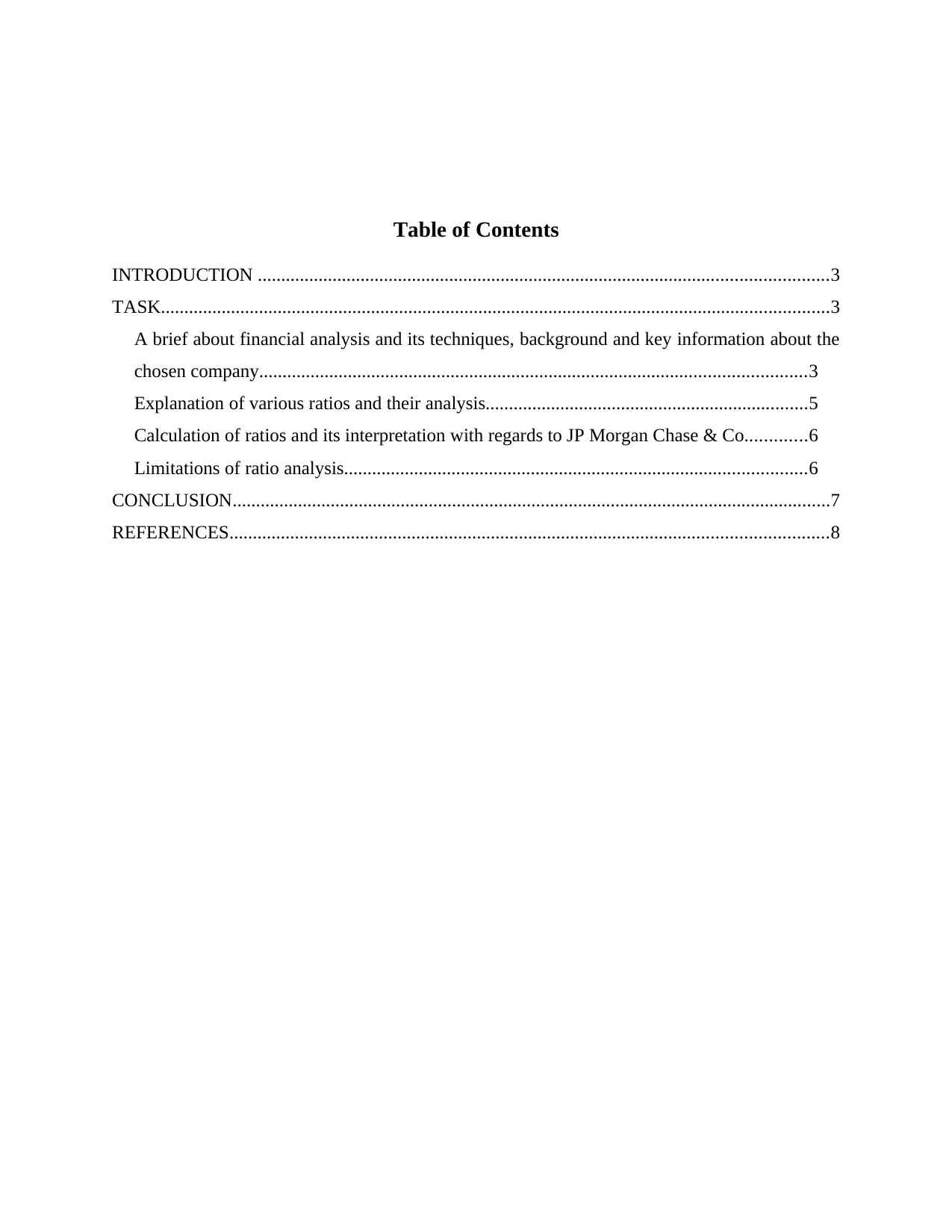
Table of Contents
INTRODUCTION ..........................................................................................................................3
TASK...............................................................................................................................................3
A brief about financial analysis and its techniques, background and key information about the
chosen company.....................................................................................................................3
Explanation of various ratios and their analysis.....................................................................5
Calculation of ratios and its interpretation with regards to JP Morgan Chase & Co.............6
Limitations of ratio analysis...................................................................................................6
CONCLUSION................................................................................................................................7
REFERENCES................................................................................................................................8
INTRODUCTION ..........................................................................................................................3
TASK...............................................................................................................................................3
A brief about financial analysis and its techniques, background and key information about the
chosen company.....................................................................................................................3
Explanation of various ratios and their analysis.....................................................................5
Calculation of ratios and its interpretation with regards to JP Morgan Chase & Co.............6
Limitations of ratio analysis...................................................................................................6
CONCLUSION................................................................................................................................7
REFERENCES................................................................................................................................8
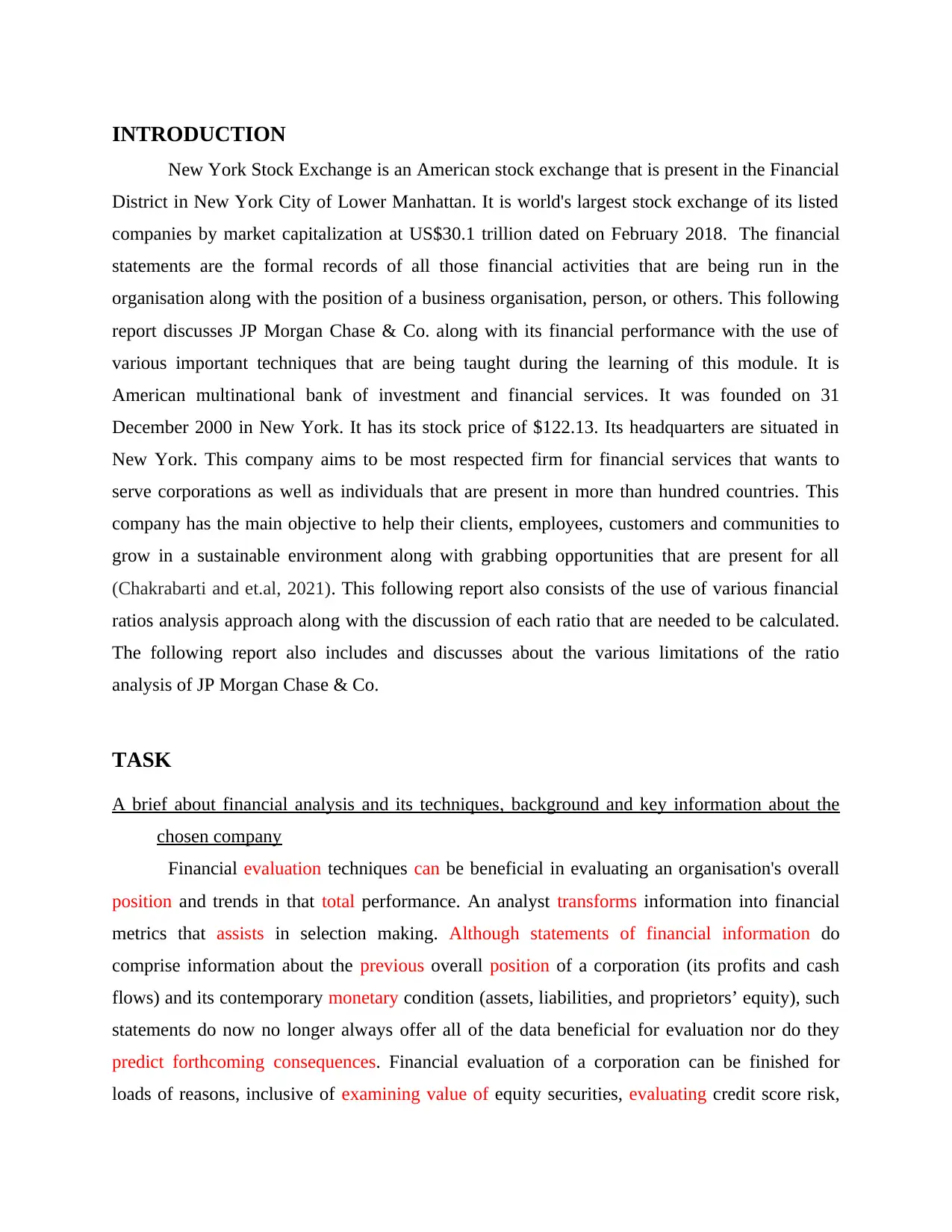
INTRODUCTION
New York Stock Exchange is an American stock exchange that is present in the Financial
District in New York City of Lower Manhattan. It is world's largest stock exchange of its listed
companies by market capitalization at US$30.1 trillion dated on February 2018. The financial
statements are the formal records of all those financial activities that are being run in the
organisation along with the position of a business organisation, person, or others. This following
report discusses JP Morgan Chase & Co. along with its financial performance with the use of
various important techniques that are being taught during the learning of this module. It is
American multinational bank of investment and financial services. It was founded on 31
December 2000 in New York. It has its stock price of $122.13. Its headquarters are situated in
New York. This company aims to be most respected firm for financial services that wants to
serve corporations as well as individuals that are present in more than hundred countries. This
company has the main objective to help their clients, employees, customers and communities to
grow in a sustainable environment along with grabbing opportunities that are present for all
(Chakrabarti and et.al, 2021). This following report also consists of the use of various financial
ratios analysis approach along with the discussion of each ratio that are needed to be calculated.
The following report also includes and discusses about the various limitations of the ratio
analysis of JP Morgan Chase & Co.
TASK
A brief about financial analysis and its techniques, background and key information about the
chosen company
Financial evaluation techniques can be beneficial in evaluating an organisation's overall
position and trends in that total performance. An analyst transforms information into financial
metrics that assists in selection making. Although statements of financial information do
comprise information about the previous overall position of a corporation (its profits and cash
flows) and its contemporary monetary condition (assets, liabilities, and proprietors’ equity), such
statements do now no longer always offer all of the data beneficial for evaluation nor do they
predict forthcoming consequences. Financial evaluation of a corporation can be finished for
loads of reasons, inclusive of examining value of equity securities, evaluating credit score risk,
New York Stock Exchange is an American stock exchange that is present in the Financial
District in New York City of Lower Manhattan. It is world's largest stock exchange of its listed
companies by market capitalization at US$30.1 trillion dated on February 2018. The financial
statements are the formal records of all those financial activities that are being run in the
organisation along with the position of a business organisation, person, or others. This following
report discusses JP Morgan Chase & Co. along with its financial performance with the use of
various important techniques that are being taught during the learning of this module. It is
American multinational bank of investment and financial services. It was founded on 31
December 2000 in New York. It has its stock price of $122.13. Its headquarters are situated in
New York. This company aims to be most respected firm for financial services that wants to
serve corporations as well as individuals that are present in more than hundred countries. This
company has the main objective to help their clients, employees, customers and communities to
grow in a sustainable environment along with grabbing opportunities that are present for all
(Chakrabarti and et.al, 2021). This following report also consists of the use of various financial
ratios analysis approach along with the discussion of each ratio that are needed to be calculated.
The following report also includes and discusses about the various limitations of the ratio
analysis of JP Morgan Chase & Co.
TASK
A brief about financial analysis and its techniques, background and key information about the
chosen company
Financial evaluation techniques can be beneficial in evaluating an organisation's overall
position and trends in that total performance. An analyst transforms information into financial
metrics that assists in selection making. Although statements of financial information do
comprise information about the previous overall position of a corporation (its profits and cash
flows) and its contemporary monetary condition (assets, liabilities, and proprietors’ equity), such
statements do now no longer always offer all of the data beneficial for evaluation nor do they
predict forthcoming consequences. Financial evaluation of a corporation can be finished for
loads of reasons, inclusive of examining value of equity securities, evaluating credit score risk,
⊘ This is a preview!⊘
Do you want full access?
Subscribe today to unlock all pages.

Trusted by 1+ million students worldwide
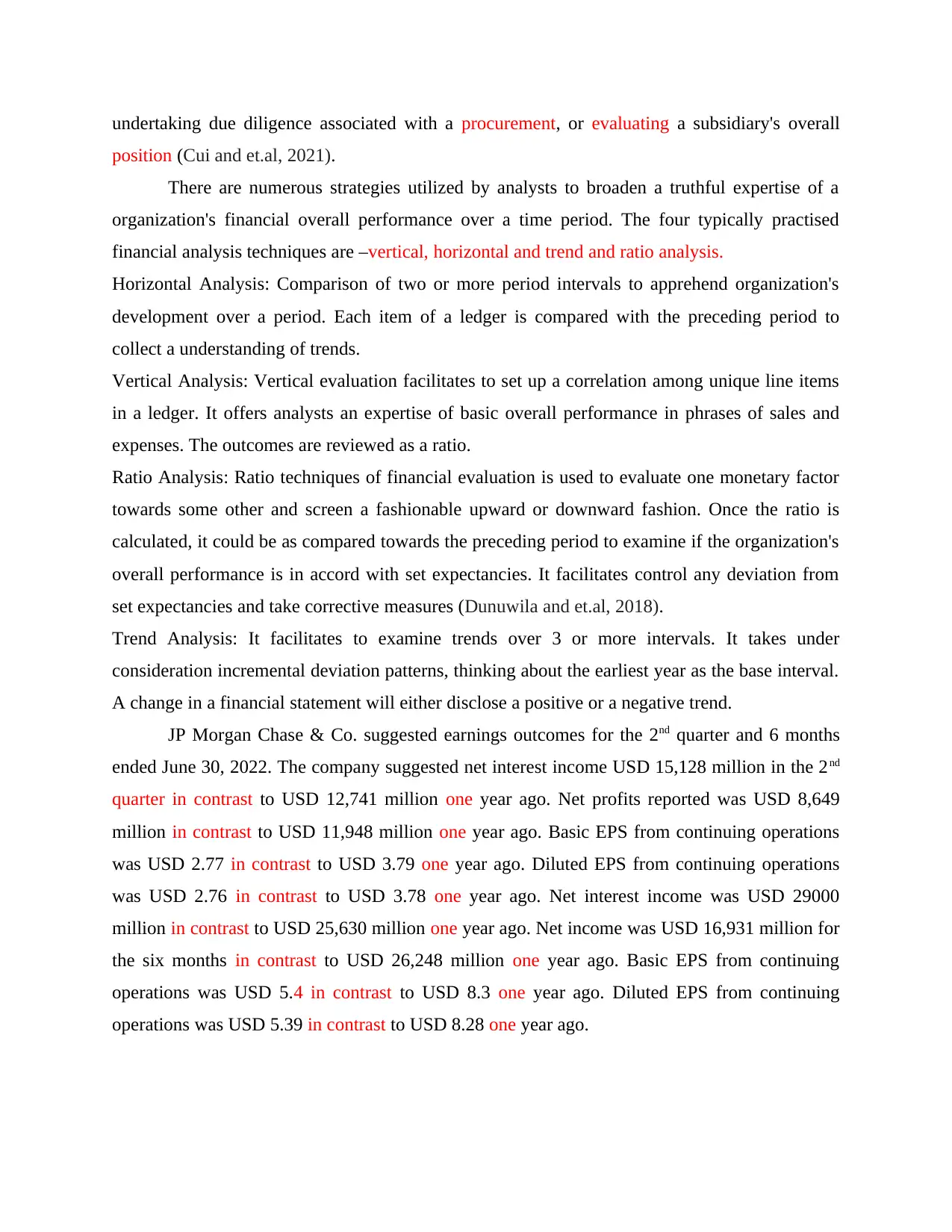
undertaking due diligence associated with a procurement, or evaluating a subsidiary's overall
position (Cui and et.al, 2021).
There are numerous strategies utilized by analysts to broaden a truthful expertise of a
organization's financial overall performance over a time period. The four typically practised
financial analysis techniques are –vertical, horizontal and trend and ratio analysis.
Horizontal Analysis: Comparison of two or more period intervals to apprehend organization's
development over a period. Each item of a ledger is compared with the preceding period to
collect a understanding of trends.
Vertical Analysis: Vertical evaluation facilitates to set up a correlation among unique line items
in a ledger. It offers analysts an expertise of basic overall performance in phrases of sales and
expenses. The outcomes are reviewed as a ratio.
Ratio Analysis: Ratio techniques of financial evaluation is used to evaluate one monetary factor
towards some other and screen a fashionable upward or downward fashion. Once the ratio is
calculated, it could be as compared towards the preceding period to examine if the organization's
overall performance is in accord with set expectancies. It facilitates control any deviation from
set expectancies and take corrective measures (Dunuwila and et.al, 2018).
Trend Analysis: It facilitates to examine trends over 3 or more intervals. It takes under
consideration incremental deviation patterns, thinking about the earliest year as the base interval.
A change in a financial statement will either disclose a positive or a negative trend.
JP Morgan Chase & Co. suggested earnings outcomes for the 2nd quarter and 6 months
ended June 30, 2022. The company suggested net interest income USD 15,128 million in the 2nd
quarter in contrast to USD 12,741 million one year ago. Net profits reported was USD 8,649
million in contrast to USD 11,948 million one year ago. Basic EPS from continuing operations
was USD 2.77 in contrast to USD 3.79 one year ago. Diluted EPS from continuing operations
was USD 2.76 in contrast to USD 3.78 one year ago. Net interest income was USD 29000
million in contrast to USD 25,630 million one year ago. Net income was USD 16,931 million for
the six months in contrast to USD 26,248 million one year ago. Basic EPS from continuing
operations was USD 5.4 in contrast to USD 8.3 one year ago. Diluted EPS from continuing
operations was USD 5.39 in contrast to USD 8.28 one year ago.
position (Cui and et.al, 2021).
There are numerous strategies utilized by analysts to broaden a truthful expertise of a
organization's financial overall performance over a time period. The four typically practised
financial analysis techniques are –vertical, horizontal and trend and ratio analysis.
Horizontal Analysis: Comparison of two or more period intervals to apprehend organization's
development over a period. Each item of a ledger is compared with the preceding period to
collect a understanding of trends.
Vertical Analysis: Vertical evaluation facilitates to set up a correlation among unique line items
in a ledger. It offers analysts an expertise of basic overall performance in phrases of sales and
expenses. The outcomes are reviewed as a ratio.
Ratio Analysis: Ratio techniques of financial evaluation is used to evaluate one monetary factor
towards some other and screen a fashionable upward or downward fashion. Once the ratio is
calculated, it could be as compared towards the preceding period to examine if the organization's
overall performance is in accord with set expectancies. It facilitates control any deviation from
set expectancies and take corrective measures (Dunuwila and et.al, 2018).
Trend Analysis: It facilitates to examine trends over 3 or more intervals. It takes under
consideration incremental deviation patterns, thinking about the earliest year as the base interval.
A change in a financial statement will either disclose a positive or a negative trend.
JP Morgan Chase & Co. suggested earnings outcomes for the 2nd quarter and 6 months
ended June 30, 2022. The company suggested net interest income USD 15,128 million in the 2nd
quarter in contrast to USD 12,741 million one year ago. Net profits reported was USD 8,649
million in contrast to USD 11,948 million one year ago. Basic EPS from continuing operations
was USD 2.77 in contrast to USD 3.79 one year ago. Diluted EPS from continuing operations
was USD 2.76 in contrast to USD 3.78 one year ago. Net interest income was USD 29000
million in contrast to USD 25,630 million one year ago. Net income was USD 16,931 million for
the six months in contrast to USD 26,248 million one year ago. Basic EPS from continuing
operations was USD 5.4 in contrast to USD 8.3 one year ago. Diluted EPS from continuing
operations was USD 5.39 in contrast to USD 8.28 one year ago.
Paraphrase This Document
Need a fresh take? Get an instant paraphrase of this document with our AI Paraphraser

Explanation of various ratios and their analysis
Financial evaluation techniques, consisting of balance sheet and ratio evaluation, are
beneficial in concluding financial reporting information and comparing the overall position and
financial function of an employer (Gupta and et.al, 2021). The effects of financial evaluation
strategies offer critical inputs into safety valuation. Key aspects of financial evaluation
encompass the following:
Balance sheets and the ratios put off the impact of size, permitting comparisons of an
organisations with competitive companies (cross-sectional evaluation) and contrast of an
organisation’s outcomes for a given period of time (time-series evaluation).
Activity ratios degree the performance of an organisation's procedures, consisting of
series of receivables or control of stock. Important activity ratios encompass stock
turnover, days of stock hold, receivables turnover, sales outstanding days, payables
turnover, no. of days of payables, turnover of working capital, turnover of fixed assets,
and overall turnover of assets.
Liquidity ratios degree the potential of an organisation to fulfil short-time period
obligations. Significant liquidity ratios encompass the current ratio, cash ratio, quick
ratio.
Solvency ratios assess the potential of an organisation to fulfil long-time period
obligations. Major solvency ratios encompass debt ratios (consisting of the debt-to-
capital ratio, debt-to-equity ratio, and financial leverage ratio) and coverage ratios
(consisting of interest coverage).
Profitability ratios assess the potential of an organisation to produce income from sales
and assets. Significant profitability ratios encompass income ratios (consisting of gross
income margin, operating income margin, pre-tax margin, and internet income margin)
and go back on funding ratios.
Ratios also can be blended and examined as a set to higher recognize how they fit collectively
and the way performance and leverage are secured to profitability. ROE may be analysed as the
product of net income margin, turnover of asset, and financial leverage. This decomposition is
every now and then known as Du-Pont analysis (Jeong and et.al, 2018).
Financial evaluation techniques, consisting of balance sheet and ratio evaluation, are
beneficial in concluding financial reporting information and comparing the overall position and
financial function of an employer (Gupta and et.al, 2021). The effects of financial evaluation
strategies offer critical inputs into safety valuation. Key aspects of financial evaluation
encompass the following:
Balance sheets and the ratios put off the impact of size, permitting comparisons of an
organisations with competitive companies (cross-sectional evaluation) and contrast of an
organisation’s outcomes for a given period of time (time-series evaluation).
Activity ratios degree the performance of an organisation's procedures, consisting of
series of receivables or control of stock. Important activity ratios encompass stock
turnover, days of stock hold, receivables turnover, sales outstanding days, payables
turnover, no. of days of payables, turnover of working capital, turnover of fixed assets,
and overall turnover of assets.
Liquidity ratios degree the potential of an organisation to fulfil short-time period
obligations. Significant liquidity ratios encompass the current ratio, cash ratio, quick
ratio.
Solvency ratios assess the potential of an organisation to fulfil long-time period
obligations. Major solvency ratios encompass debt ratios (consisting of the debt-to-
capital ratio, debt-to-equity ratio, and financial leverage ratio) and coverage ratios
(consisting of interest coverage).
Profitability ratios assess the potential of an organisation to produce income from sales
and assets. Significant profitability ratios encompass income ratios (consisting of gross
income margin, operating income margin, pre-tax margin, and internet income margin)
and go back on funding ratios.
Ratios also can be blended and examined as a set to higher recognize how they fit collectively
and the way performance and leverage are secured to profitability. ROE may be analysed as the
product of net income margin, turnover of asset, and financial leverage. This decomposition is
every now and then known as Du-Pont analysis (Jeong and et.al, 2018).
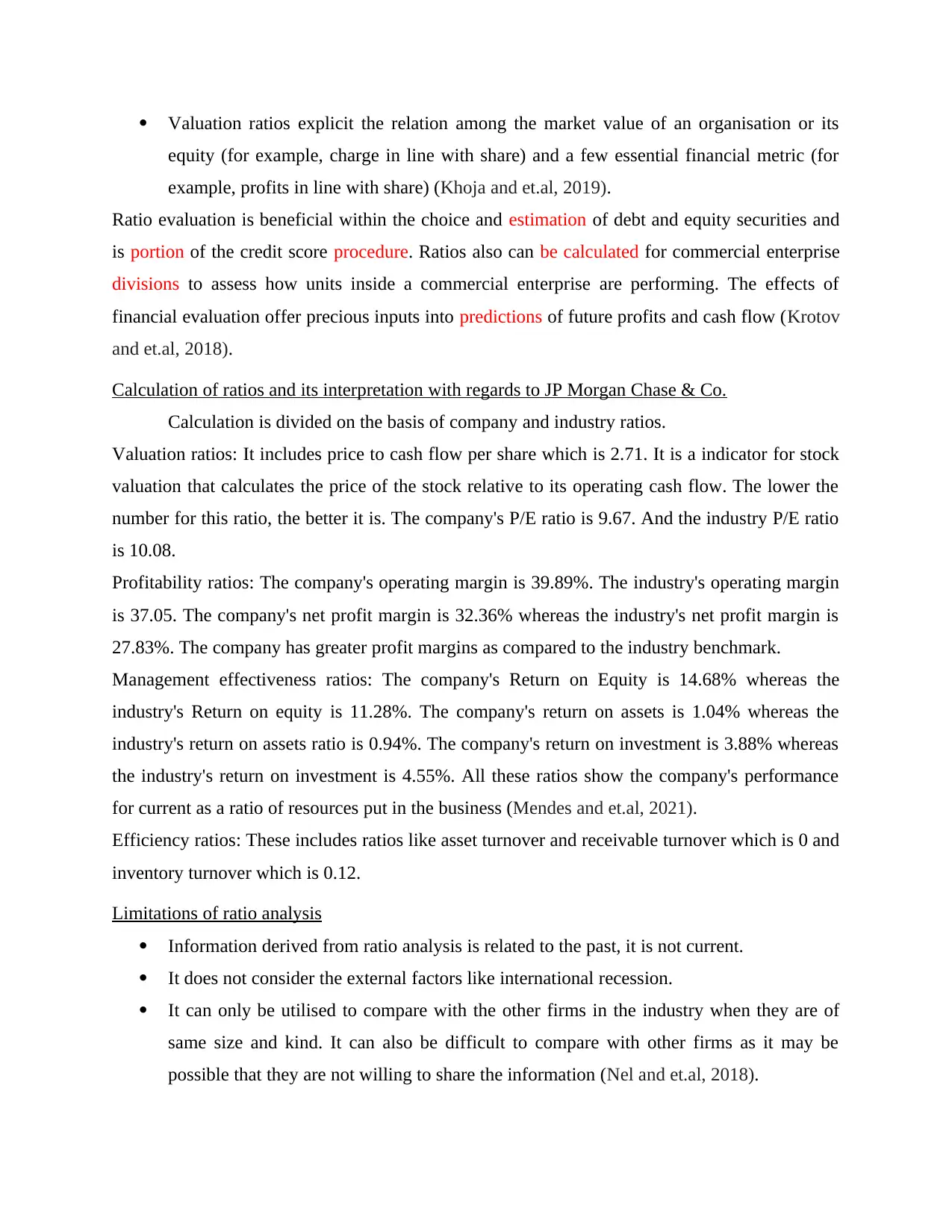
Valuation ratios explicit the relation among the market value of an organisation or its
equity (for example, charge in line with share) and a few essential financial metric (for
example, profits in line with share) (Khoja and et.al, 2019).
Ratio evaluation is beneficial within the choice and estimation of debt and equity securities and
is portion of the credit score procedure. Ratios also can be calculated for commercial enterprise
divisions to assess how units inside a commercial enterprise are performing. The effects of
financial evaluation offer precious inputs into predictions of future profits and cash flow (Krotov
and et.al, 2018).
Calculation of ratios and its interpretation with regards to JP Morgan Chase & Co.
Calculation is divided on the basis of company and industry ratios.
Valuation ratios: It includes price to cash flow per share which is 2.71. It is a indicator for stock
valuation that calculates the price of the stock relative to its operating cash flow. The lower the
number for this ratio, the better it is. The company's P/E ratio is 9.67. And the industry P/E ratio
is 10.08.
Profitability ratios: The company's operating margin is 39.89%. The industry's operating margin
is 37.05. The company's net profit margin is 32.36% whereas the industry's net profit margin is
27.83%. The company has greater profit margins as compared to the industry benchmark.
Management effectiveness ratios: The company's Return on Equity is 14.68% whereas the
industry's Return on equity is 11.28%. The company's return on assets is 1.04% whereas the
industry's return on assets ratio is 0.94%. The company's return on investment is 3.88% whereas
the industry's return on investment is 4.55%. All these ratios show the company's performance
for current as a ratio of resources put in the business (Mendes and et.al, 2021).
Efficiency ratios: These includes ratios like asset turnover and receivable turnover which is 0 and
inventory turnover which is 0.12.
Limitations of ratio analysis
Information derived from ratio analysis is related to the past, it is not current.
It does not consider the external factors like international recession.
It can only be utilised to compare with the other firms in the industry when they are of
same size and kind. It can also be difficult to compare with other firms as it may be
possible that they are not willing to share the information (Nel and et.al, 2018).
equity (for example, charge in line with share) and a few essential financial metric (for
example, profits in line with share) (Khoja and et.al, 2019).
Ratio evaluation is beneficial within the choice and estimation of debt and equity securities and
is portion of the credit score procedure. Ratios also can be calculated for commercial enterprise
divisions to assess how units inside a commercial enterprise are performing. The effects of
financial evaluation offer precious inputs into predictions of future profits and cash flow (Krotov
and et.al, 2018).
Calculation of ratios and its interpretation with regards to JP Morgan Chase & Co.
Calculation is divided on the basis of company and industry ratios.
Valuation ratios: It includes price to cash flow per share which is 2.71. It is a indicator for stock
valuation that calculates the price of the stock relative to its operating cash flow. The lower the
number for this ratio, the better it is. The company's P/E ratio is 9.67. And the industry P/E ratio
is 10.08.
Profitability ratios: The company's operating margin is 39.89%. The industry's operating margin
is 37.05. The company's net profit margin is 32.36% whereas the industry's net profit margin is
27.83%. The company has greater profit margins as compared to the industry benchmark.
Management effectiveness ratios: The company's Return on Equity is 14.68% whereas the
industry's Return on equity is 11.28%. The company's return on assets is 1.04% whereas the
industry's return on assets ratio is 0.94%. The company's return on investment is 3.88% whereas
the industry's return on investment is 4.55%. All these ratios show the company's performance
for current as a ratio of resources put in the business (Mendes and et.al, 2021).
Efficiency ratios: These includes ratios like asset turnover and receivable turnover which is 0 and
inventory turnover which is 0.12.
Limitations of ratio analysis
Information derived from ratio analysis is related to the past, it is not current.
It does not consider the external factors like international recession.
It can only be utilised to compare with the other firms in the industry when they are of
same size and kind. It can also be difficult to compare with other firms as it may be
possible that they are not willing to share the information (Nel and et.al, 2018).
⊘ This is a preview!⊘
Do you want full access?
Subscribe today to unlock all pages.

Trusted by 1+ million students worldwide

Changes in accounting policies can significantly affect financial reporting. The
accounting principles and procedures used in analysis of ratios are changed. The after
change recorded financial outcomes are not comparable to the results before the change
(Wimmer, H. and Rada, R., 2019).
CONCLUSION
The main source of information is an organisation's annual report inclusive of statements
of financial information and its notes and commentary of management. This report specializes in
information provided in financial reports organized in IFRS and US GAAP. However, financial
reports do now no longer comprise all of the data had to carry out powerful financial evaluation.
This report describes diverse strategies used to investigate a corporation's financial statements.
The report analyses in brief the ratio analysis for JP Morgan Chase & Co showing also the
various techniques and tools for analysis. Despite for all the advantages of ratio analysis, it has
some limitations too which are mentioned in the end of the report. Ratio analysis does not
address certain elements which can play a vital role in discovering the prospects of an
organisation.
accounting principles and procedures used in analysis of ratios are changed. The after
change recorded financial outcomes are not comparable to the results before the change
(Wimmer, H. and Rada, R., 2019).
CONCLUSION
The main source of information is an organisation's annual report inclusive of statements
of financial information and its notes and commentary of management. This report specializes in
information provided in financial reports organized in IFRS and US GAAP. However, financial
reports do now no longer comprise all of the data had to carry out powerful financial evaluation.
This report describes diverse strategies used to investigate a corporation's financial statements.
The report analyses in brief the ratio analysis for JP Morgan Chase & Co showing also the
various techniques and tools for analysis. Despite for all the advantages of ratio analysis, it has
some limitations too which are mentioned in the end of the report. Ratio analysis does not
address certain elements which can play a vital role in discovering the prospects of an
organisation.
Paraphrase This Document
Need a fresh take? Get an instant paraphrase of this document with our AI Paraphraser
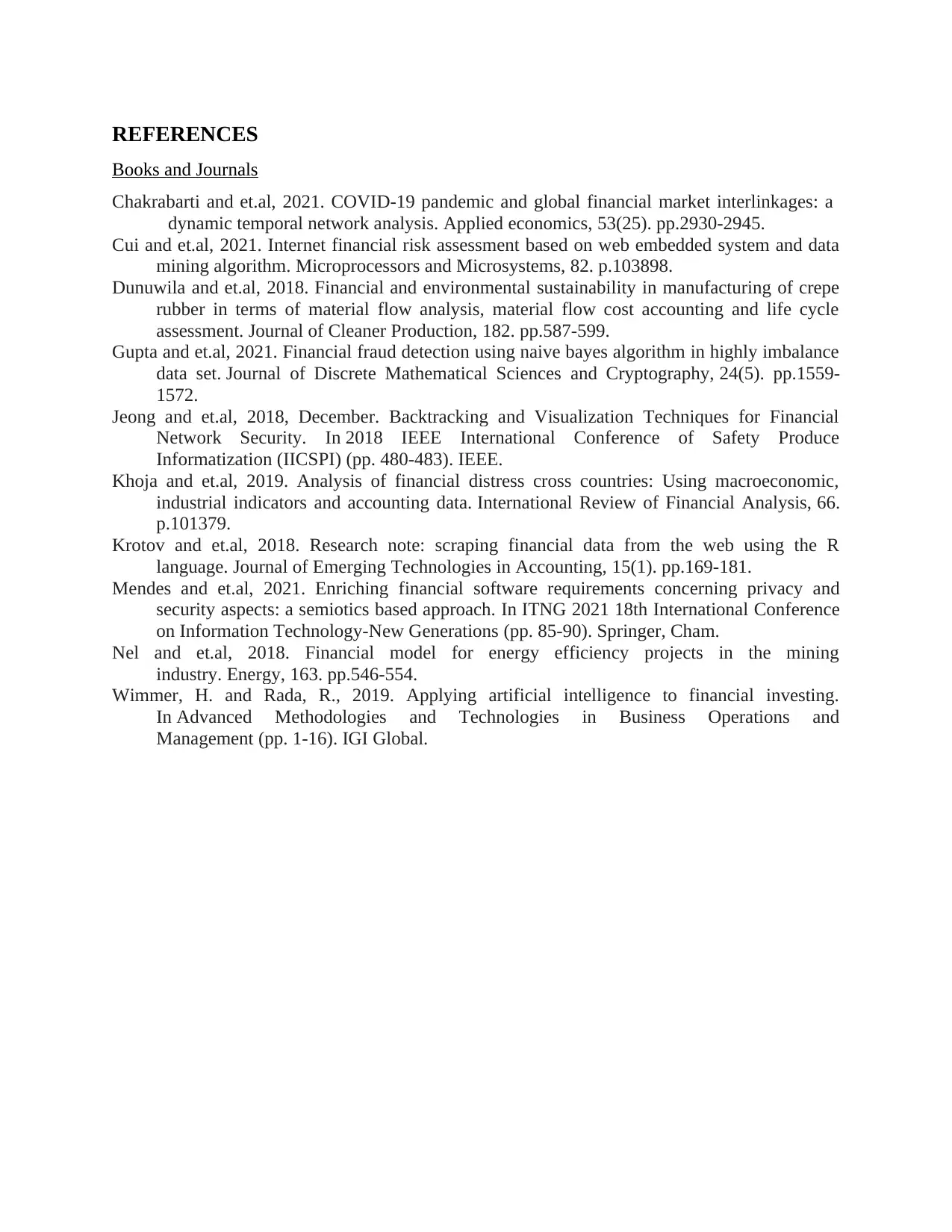
REFERENCES
Books and Journals
Chakrabarti and et.al, 2021. COVID-19 pandemic and global financial market interlinkages: a
dynamic temporal network analysis. Applied economics, 53(25). pp.2930-2945.
Cui and et.al, 2021. Internet financial risk assessment based on web embedded system and data
mining algorithm. Microprocessors and Microsystems, 82. p.103898.
Dunuwila and et.al, 2018. Financial and environmental sustainability in manufacturing of crepe
rubber in terms of material flow analysis, material flow cost accounting and life cycle
assessment. Journal of Cleaner Production, 182. pp.587-599.
Gupta and et.al, 2021. Financial fraud detection using naive bayes algorithm in highly imbalance
data set. Journal of Discrete Mathematical Sciences and Cryptography, 24(5). pp.1559-
1572.
Jeong and et.al, 2018, December. Backtracking and Visualization Techniques for Financial
Network Security. In 2018 IEEE International Conference of Safety Produce
Informatization (IICSPI) (pp. 480-483). IEEE.
Khoja and et.al, 2019. Analysis of financial distress cross countries: Using macroeconomic,
industrial indicators and accounting data. International Review of Financial Analysis, 66.
p.101379.
Krotov and et.al, 2018. Research note: scraping financial data from the web using the R
language. Journal of Emerging Technologies in Accounting, 15(1). pp.169-181.
Mendes and et.al, 2021. Enriching financial software requirements concerning privacy and
security aspects: a semiotics based approach. In ITNG 2021 18th International Conference
on Information Technology-New Generations (pp. 85-90). Springer, Cham.
Nel and et.al, 2018. Financial model for energy efficiency projects in the mining
industry. Energy, 163. pp.546-554.
Wimmer, H. and Rada, R., 2019. Applying artificial intelligence to financial investing.
In Advanced Methodologies and Technologies in Business Operations and
Management (pp. 1-16). IGI Global.
Books and Journals
Chakrabarti and et.al, 2021. COVID-19 pandemic and global financial market interlinkages: a
dynamic temporal network analysis. Applied economics, 53(25). pp.2930-2945.
Cui and et.al, 2021. Internet financial risk assessment based on web embedded system and data
mining algorithm. Microprocessors and Microsystems, 82. p.103898.
Dunuwila and et.al, 2018. Financial and environmental sustainability in manufacturing of crepe
rubber in terms of material flow analysis, material flow cost accounting and life cycle
assessment. Journal of Cleaner Production, 182. pp.587-599.
Gupta and et.al, 2021. Financial fraud detection using naive bayes algorithm in highly imbalance
data set. Journal of Discrete Mathematical Sciences and Cryptography, 24(5). pp.1559-
1572.
Jeong and et.al, 2018, December. Backtracking and Visualization Techniques for Financial
Network Security. In 2018 IEEE International Conference of Safety Produce
Informatization (IICSPI) (pp. 480-483). IEEE.
Khoja and et.al, 2019. Analysis of financial distress cross countries: Using macroeconomic,
industrial indicators and accounting data. International Review of Financial Analysis, 66.
p.101379.
Krotov and et.al, 2018. Research note: scraping financial data from the web using the R
language. Journal of Emerging Technologies in Accounting, 15(1). pp.169-181.
Mendes and et.al, 2021. Enriching financial software requirements concerning privacy and
security aspects: a semiotics based approach. In ITNG 2021 18th International Conference
on Information Technology-New Generations (pp. 85-90). Springer, Cham.
Nel and et.al, 2018. Financial model for energy efficiency projects in the mining
industry. Energy, 163. pp.546-554.
Wimmer, H. and Rada, R., 2019. Applying artificial intelligence to financial investing.
In Advanced Methodologies and Technologies in Business Operations and
Management (pp. 1-16). IGI Global.
1 out of 8
Related Documents
Your All-in-One AI-Powered Toolkit for Academic Success.
+13062052269
info@desklib.com
Available 24*7 on WhatsApp / Email
![[object Object]](/_next/static/media/star-bottom.7253800d.svg)
Unlock your academic potential
Copyright © 2020–2025 A2Z Services. All Rights Reserved. Developed and managed by ZUCOL.




